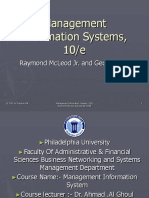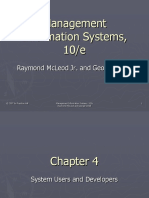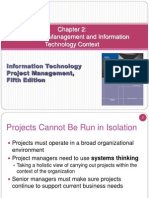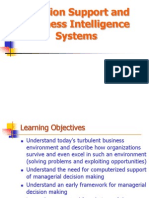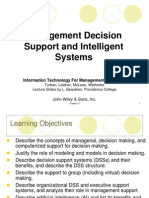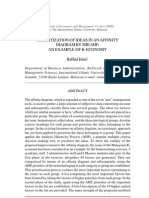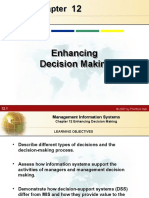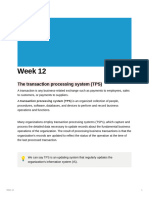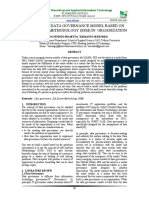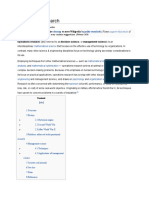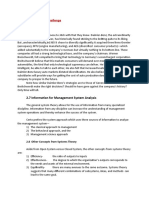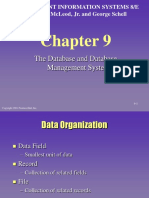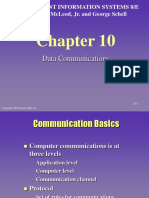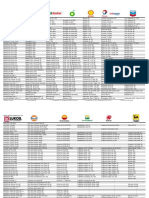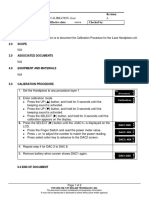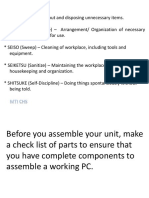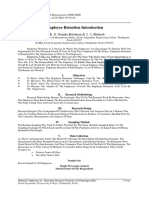0 ratings0% found this document useful (0 votes)
94 viewsMcLeod CH11
McLeod CH11
Uploaded by
Abdul LatifCopyright:
© All Rights Reserved
Available Formats
Download as PPT, PDF, TXT or read online from Scribd
McLeod CH11
McLeod CH11
Uploaded by
Abdul Latif0 ratings0% found this document useful (0 votes)
94 views48 pagesOriginal Title
McLeod_CH11.ppt
Copyright
© © All Rights Reserved
Available Formats
PPT, PDF, TXT or read online from Scribd
Share this document
Did you find this document useful?
Is this content inappropriate?
Copyright:
© All Rights Reserved
Available Formats
Download as PPT, PDF, TXT or read online from Scribd
Download as ppt, pdf, or txt
0 ratings0% found this document useful (0 votes)
94 views48 pagesMcLeod CH11
McLeod CH11
Uploaded by
Abdul LatifCopyright:
© All Rights Reserved
Available Formats
Download as PPT, PDF, TXT or read online from Scribd
Download as ppt, pdf, or txt
You are on page 1of 48
Management
Information Systems,
10/e
Raymond McLeod Jr. and George P. Schell
© 2007 by Prentice Hall Management Information Systems, 10/e 1
Raymond McLeod and George Schell
Chapter 11
Decision Support Systems
© 2007 by Prentice Hall Management Information Systems, 10/e 2
Raymond McLeod and George Schell
Learning Objectives
► Understand the fundamentals of decision
making and problem solving.
► Know how the decision support system
(DSS) concept originated.
► Know the fundamentals of mathematical
modeling.
► Know how to use an electronic spreadsheet
as a mathematical model.
© 2007 by Prentice Hall Management Information Systems, 10/e 3
Raymond McLeod and George Schell
Learning Objectives (Cont’d)
► Be familiar with how artificial intelligence
emerged as a computer application and
know its main areas.
► Know the four basic parts of an expert
system.
► Know what a group decision support system
(GDSS) is and the different environmental
settings that can be used.
© 2007 by Prentice Hall Management Information Systems, 10/e 4
Raymond McLeod and George Schell
Problem-Solving and Decision
Making Review
► Problem solving consists of response to
things going well and also to things going
badly.
► Problem is a condition or event that is
harmful or potentially harmful to a firm or
that is beneficial or potentially beneficial.
► Decision making is the act of selecting
from alternative problem solutions.
► Decision is a selected course of action.
© 2007 by Prentice Hall Management Information Systems, 10/e 5
Raymond McLeod and George Schell
Problem-Solving Phases
► Herbert A. Simon’s four basic phases:
Intelligence activity–Searching the
environment for conditions calling for a solution.
Design activity–inventing, developing, and
analyzing possible course of actions.
Choice activity–Selecting a particular course
of action from those available.
Review activity–Assessing past choices.
© 2007 by Prentice Hall Management Information Systems, 10/e 6
Raymond McLeod and George Schell
Frameworks and Systems Approach
► Problem-solving frameworks
General systems model of the firm.
Eight-element environmental model.
► Systems approach to problem-solving,
involves a series of steps grouped into three
phases–preparation effort, definition effort,
and solution effort.
© 2007 by Prentice Hall Management Information Systems, 10/e 7
Raymond McLeod and George Schell
The Importance of a Systems View
► Systems view which regards business operations as
systems embedded within a larger environmental setting;
abstract way of thinking; potential value to the manager.
Prevents the manager from getting lost in the
complexity of the organizational structure and details of
the job.
Recognizes the necessity of having good objectives.
Emphasizes the importance of all of the parts of the
organization working together.
Acknowledges the interconnections of the organization
with its environment.
Places a high value on feedback information that can
only be achieved by means of a closed-loop system.
© 2007 by Prentice Hall Management Information Systems, 10/e 8
Raymond McLeod and George Schell
Building on the Concepts
► Elements of a problem-solving phase.
Desired state–what the system should achieve.
Current state–what the system is now achieving.
Solution criterion–difference between the current state
and the desired state.
► Constraints.
Internal take the form of limited resources that exist within
the firm.
Environmental take the form of pressures from various
environmental elements that restrict the flow of resources
into and out of the firm.
► When all of these elements exist and the manager understands
them, a solution to the problem is possible!
© 2007 by Prentice Hall Management Information Systems, 10/e 9
Raymond McLeod and George Schell
Figure 11.1 Elements of the
Problem-Solving Process
© 2007 by Prentice Hall Management Information Systems, 10/e 10
Raymond McLeod and George Schell
Selecting the Best Solution
► Henry Mintzberg, management theorist, has
identified three approaches:
► Analysis–a systematic evaluation of
options.
► Judgment–the mental process of a single
manager.
► Bargaining–negotiations between several
managers.
© 2007 by Prentice Hall Management Information Systems, 10/e 11
Raymond McLeod and George Schell
Problem vs. Symptoms
► Symptom is a condition produced by the problem.
► Structured problem consists of elements and
relationships between elements, all of which are
understood by the problem solver.
► Unstructured problem is one that contains no
elements or relationships between elements that are
understood by the problem solver.
► Semistructured problem is one that contains some
elements or relationships that are understood by the
problem solver and some that are not.
© 2007 by Prentice Hall Management Information Systems, 10/e 12
Raymond McLeod and George Schell
Types of Decisions
► Programmed decisions are “repetitive and routine,
to the extent that a definite procedure has been
worked out for handling them so that they don’t
have to be treated de novo (as new) each time
they occur.”
► Nonprogrammed decisions are “novel, unstructured,
and unusually consequential. There’s no cut-and-
dried method for handling the problem because its
precise nature and structure are elusive or
complex, and or because it is so important that it
deserves a custom-tailored treatment.”
© 2007 by Prentice Hall Management Information Systems, 10/e 13
Raymond McLeod and George Schell
Decision Support Systems
► Gorry and Scott Morton (1971) argued that an information
system that focused on single problems faced by single
managers would provide better support.
► Central to their concept was a table, called the Gorry-Scott
Morton grid (Figure 11.2) that classifies problems in terms
of problem structure and management level.
► The top level is called the strategic planning level, the
middle level-the management control level, and the lower
level-the operational control level.
► Gorry and Scott Morton also used the term decision
support system (DSS) to describe the systems that could
provide the needed support.
© 2007 by Prentice Hall Management Information Systems, 10/e 14
Raymond McLeod and George Schell
Figure 11.2 The Gorry and Scott-
Morton Grid
© 2007 by Prentice Hall Management Information Systems, 10/e 15
Raymond McLeod and George Schell
A DSS Model
► Originally the DSS was conceived to produce periodic and
special reports (responses to database queries), and
outputs from mathematical models.
► An ability was added to permit problem solvers to work in
groups.
► The addition of groupware enabled the system to function
as a group decision support system (GDSS).
► Figure 11.3 is a model of a DSS. The arrow at the bottom
indicates how the configuration has expanded over time.
► More recently, artificial intelligence (AI) capability has been
added, along with an ability to engage in on-line analytical
programming (OLAP).
© 2007 by Prentice Hall Management Information Systems, 10/e 16
Raymond McLeod and George Schell
Figure 11.3 A DSS Model that Incorporates
Group Decision Support, OLAP, and Artificial
Intelligence
© 2007 by Prentice Hall Management Information Systems, 10/e 17
Raymond McLeod and George Schell
Mathematical Modeling
► Model is an abstraction of something. It represents some
object or activity, which is called an entity.
► There are four basic types of models:
Physical model is a three-dimensional representation
of its entity.
Narrative model, which describes its entity with
spoken or written words.
Graphic model represents its entity with an
abstraction of lines, symbols, or shapes (Figure 11.4).
► Economic order quantity (EOQ) is the optimum quantity of
replenishment stock to order from a supplier.
Mathematical model is any mathematical formula or
equation.
© 2007 by Prentice Hall Management Information Systems, 10/e 18
Raymond McLeod and George Schell
Formula to Compute Economic Order
Quantity (EOQ)
© 2007 by Prentice Hall Management Information Systems, 10/e 19
Raymond McLeod and George Schell
Figure 11.4 A Graphical Concept Model of the
Economic Order Quantity
© 2007 by Prentice Hall Management Information Systems, 10/e 20
Raymond McLeod and George Schell
Uses of Models
► Facilitate Understanding: Once a simple model is
understood, it can gradually be made more complex so as
to more accurately represent its entity.
► Facilitate Communication: All four types of models can
communicate information quickly and accurately.
► Predict the Future: The mathematical model can predict
what might happen in the future but a manager must use
judgment and intuition in evaluating the output.
► A mathematical model can be classified in terms of three
dimensions: the influence of time, the degree of certainty,
and the ability to achieve optimization.
© 2007 by Prentice Hall Management Information Systems, 10/e 21
Raymond McLeod and George Schell
Classes of Mathematical Models
► Static model doesn’t include time as a variable but deals
only with a particular point in time.
► Dynamic model includes time as a variable; it represents
the behavior of the entity over time.
► Probabilistic model includes probabilities. Otherwise, it
is a deterministic model.
Probability is the chance that something will happen.
► Optimizing model is one that selects the best solution
among the alternatives.
► Suboptimizing model (satisficing model) does not
identify the decisions that will produce the best outcome
but leaves that task to the manager.
© 2007 by Prentice Hall Management Information Systems, 10/e 22
Raymond McLeod and George Schell
Simulation
► The act of using a model is called simulation while the
term scenario is used to describe the conditions that
influence a simulation.
► For example, if you are simulating an inventory system, as
shown in Figure 11.5, the scenario specifies the beginning
balance and the daily sales units.
► Models can be designed so that the scenario data
elements are variables, thus enabling different values to
be assigned.
► The input values the manager enters to gauge their impact
on the entity are known as decision variables.
► Figure 11.5 gives an example of decision variables such as
order quantity, reorder point, and lead time.
© 2007 by Prentice Hall Management Information Systems, 10/e 23
Raymond McLeod and George Schell
Figure 11.5 Scenario Data and
Decision Variables from a Simulation
© 2007 by Prentice Hall Management Information Systems, 10/e 24
Raymond McLeod and George Schell
Simulation Technique and Format of
Simulation Output
► The manager usually executes an optimizing
model only a single time.
► Suboptimizing models, however, are run over and
over, in a search for the combination of decision
variables that produces a satisfying outcome
(known as playing the what-if game).
► Each time the model is run, only one decision
variable should be changed, so its influence can be
seen.
► This way, the problem solver systematically
discovers the combination of decisions leading to a
desirable solution.
© 2007 by Prentice Hall Management Information Systems, 10/e 25
Raymond McLeod and George Schell
A Modeling Example
► A firm’s executives may use a math model to assist in making key
decisions and to simulate the effect of:
Price of the product;
Amount of plant investment;
Amount to be invested in marketing activity;
Amount to be invested in R & D.
► Furthermore, executives want to simulate 4 quarters of activity and
produce 2 reports: an operating statement and an income statement.
► Figures 11.6 and 11.7 shows the input screen used to enter the
scenario data elements for the prior quarter and next quarter,
respectively.
© 2007 by Prentice Hall Management Information Systems, 10/e 26
Raymond McLeod and George Schell
Figure 11.6 A Model Input Screen for Entering
Scenario Data for the Prior Quarter
© 2007 by Prentice Hall Management Information Systems, 10/e 27
Raymond McLeod and George Schell
Figure 11.7 A Model Input Screen for Entering
Scenario Data for the Next Quarter
© 2007 by Prentice Hall Management Information Systems, 10/e 28
Raymond McLeod and George Schell
Model Output
► The next quarter’s activity (Quarter 1) is simulated, and
the after-tax profit is displayed on the screen.
► The executives then study the figure and decide on the set
of decisions to be used in Quarter 2. These decisions are
entered and the simulation is repeated.
► This process continues until all four quarters have been
simulated. At this point the screen has the appearance
shown in Figure 11.8.
► The operating statement in Figure 11.9 and the income
statement in Figure 11.10 are displayed on separate
screens.
© 2007 by Prentice Hall Management Information Systems, 10/e 29
Raymond McLeod and George Schell
Figure 11.8 Summary Output from
the Model
© 2007 by Prentice Hall Management Information Systems, 10/e 30
Raymond McLeod and George Schell
Figure 11.9 The Operating Statement Shows
Nonmonetary Results of the Simulation
© 2007 by Prentice Hall Management Information Systems, 10/e 31
Raymond McLeod and George Schell
Figure 11.10 The Income Statement Shows
Monetary Results of the Simulation
© 2007 by Prentice Hall Management Information Systems, 10/e 32
Raymond McLeod and George Schell
Modeling Advantages and
Disadvantages
► Advantages:
The modeling process is a learning experience.
The speed of the simulation process enables the consideration of a
larger number of alternatives.
Models provide a predictive power-a look into the future-that no
other information-producing method offers.
Models are less expensive than the trial-and-error method.
► Disadvantages:
The difficulty of modeling a business system will produce a model
that does not capture all of the influences on the entity.
A high degree of mathematical skill is required to develop and
properly interpret the output of complex models.
© 2007 by Prentice Hall Management Information Systems, 10/e 33
Raymond McLeod and George Schell
Mathematical Modeling Using
Electronic Spreadsheets
► The technological breakthrough that enabled problem solvers to
develop their own math models was the electronic spreadsheet.
► Static model: Figure 11.11 shows an operating budget in
column form. The columns are for: the budgeted expenses,
actual expenses, and variance, while rows are used for the
various expense items.
► A spreadsheet is especially well-suited for use as a dynamic
model. The columns are excellent for the time periods, as
illustrated in Figure 11.12.
► A spreadsheet also lends itself to playing the “what-if” game,
where the problem solver manipulates 1 or more variables to
see the effect on the outcome of the simulation.
© 2007 by Prentice Hall Management Information Systems, 10/e 34
Raymond McLeod and George Schell
Figure 11.11 Spreadsheet Rows and Columns
Provide the Format for Columnar Report
© 2007 by Prentice Hall Management Information Systems, 10/e 35
Raymond McLeod and George Schell
Figure 11.12 Spreadsheet Columns Are
Excellent for Time Periods in a Dynamic Model
© 2007 by Prentice Hall Management Information Systems, 10/e 36
Raymond McLeod and George Schell
Spreadsheet Model Interface
► When using a spreadsheet as a mathematical model, the
user can enter data or make changes directly to the
spreadsheet cells, or by using a GUI.
► The pricing model described earlier in Figures 11.6-11.10
could have been developed using a spreadsheet, and had
the graphical user interface added.
► The interface could be created using a programming
language such as Visual Basic and would likely require an
information specialist to develop.
► A development approach would be for the user to develop
the spreadsheet and then have the interface added by an
information specialist.
© 2007 by Prentice Hall Management Information Systems, 10/e 37
Raymond McLeod and George Schell
Artificial Intelligence
► Artificial intelligence (AI) is the activity of providing
such machines as computers with the ability to display
behavior that would be regarded as intelligent if it were
observed in humans.
► AI is being applied in business in knowledge-based
systems, which use human knowledge to solve problems.
► The most popular type of knowledge-based system are
expert systems, which are computer programs that try to
represent the knowledge of human experts in the form of
heuristics.
► These heuristics allow an expert system to consult on how
to solve a problem: called a consultation-the user consults
the expert system for advice.
© 2007 by Prentice Hall Management Information Systems, 10/e 38
Raymond McLeod and George Schell
Areas of AI
► Expert system is a computer program that
attempts to represent the knowledge of human
experts in the form of heuristics.
► Heuristic is a rule of thumb or a rule of good
guessing.
► Consultation is the act of using an expert
system.
► Knowledge engineer has special expertise in
artificial intelligence; adept in obtaining knowledge
from the expert.
© 2007 by Prentice Hall Management Information Systems, 10/e 39
Raymond McLeod and George Schell
Areas of AI (Cont’d)
► Neural networks mimic the physiology of
the human brain.
► Genetic algorithms apply the “survival of
the fittest” process to enable problem
solvers to produce increasingly better
problem solutions.
► Intelligent agents are used to perform
repetitive computer-related tasks; i.e., data
mining.
© 2007 by Prentice Hall Management Information Systems, 10/e 40
Raymond McLeod and George Schell
The Expert System Configuration
► User interface enables the manager to enter
instructions and information into the expert
system and to receive information from it.
► Knowledge base contains both facts that
describe the problem area and knowledge
representation techniques that describe how the
facts fit together in a logical manner.
► Problem domain is used to describe the problem
area.
© 2007 by Prentice Hall Management Information Systems, 10/e 41
Raymond McLeod and George Schell
The Expert System Configuration
(Cont’d)
► Rule specifies what to do in a given situation and
consists of two parts:
A condition that may or may not be true, and
An action to be taken when the condition is true.
► Inference engine is the portion of the expert
system that performs reasoning by using the
contents of the knowledge base in a particular
sequence.
► Goal variable is assigning a value to the problem
solution.
© 2007 by Prentice Hall Management Information Systems, 10/e 42
Raymond McLeod and George Schell
The Expert System Configuration
(Cont’d)
► Expert system shell is a ready-made processor
that can be tailored to a specific problem domain
through the addition of the appropriate knowledge
base.
► Case-based reasoning (CBR) uses historical
data as the basis for identifying problems and
recommending solutions.
► Decision tree is a network-like structure that
enables the user to progress from the root
through the network of branches by answering
questions relating to the problem.
© 2007 by Prentice Hall Management Information Systems, 10/e 43
Raymond McLeod and George Schell
Figure 11.13 An Expert System
Model
© 2007 by Prentice Hall Management Information Systems, 10/e 44
Raymond McLeod and George Schell
Group Decision Support System
► Group decision support system (GDSS) is “a
computer-based system that supports groups of
people engaged in a common task (or goal) and that
provides an interface to a shared environment”.
► Aliases group support system (GSS), computer-
supported cooperative work (CSCW),
computerized collaborative work support, and
electronic meeting system (EMS).
► Groupware the software used in these settings.
► Improved communications make possible improved
decisions.
© 2007 by Prentice Hall Management Information Systems, 10/e 45
Raymond McLeod and George Schell
GDSS Environmental Settings
► Synchronous exchange when members meet at the
same time.
► Asynchronous exchange when members meet at
different times.
► Decision room is the setting for small groups of people
meeting face-to-face.
► Facilitator is the person whose chief task is to keep the
discussion on track.
► Parallel communication is when all participants enter
comments at the same time.
► Anonymity is when nobody is able to tell who entered a
particular comment; participants say what they REALLY
think without fear.
© 2007 by Prentice Hall Management Information Systems, 10/e 46
Raymond McLeod and George Schell
Figure 11.14 Group Size and Location
Determine DSS Environmental Settings
© 2007 by Prentice Hall Management Information Systems, 10/e 47
Raymond McLeod and George Schell
GDSS Environmental Settings
(Cont’d)
► Local area decision network-when it is impossible for
small groups of people to meet face-to-face, the members
can interact by means of a local area network, or LAN.
► Legislative session-when the group is too large for a
decision room.
Imposes certain constraints on communications such as equal
participation by each member is removed or less time is available.
► Computer-mediated conference-several virtual office
applications permit communication between large groups
with geographically dispersed members.
Teleconferencing applications include computer conferencing, audio
conferencing, and videoconferencing.
© 2007 by Prentice Hall Management Information Systems, 10/e 48
Raymond McLeod and George Schell
You might also like
- Strategic Project Management Made Simple: Practical Tools for Leaders and TeamsFrom EverandStrategic Project Management Made Simple: Practical Tools for Leaders and TeamsRating: 3.5 out of 5 stars3.5/5 (8)
- McLeod CH01Document29 pagesMcLeod CH01Syed Owais Naseem100% (1)
- DSS MaterialDocument18 pagesDSS MaterialChendra 何荣健 CenNo ratings yet
- Freightliner Coronado SD: SectionDocument23 pagesFreightliner Coronado SD: SectionhoangnhuphuocNo ratings yet
- Chapter 5 INSY 4101 Supporting Decistion MakingDocument128 pagesChapter 5 INSY 4101 Supporting Decistion MakingArmoniem BezabihNo ratings yet
- Sistem Informasi Manajemen McLeod Chapter 01Document29 pagesSistem Informasi Manajemen McLeod Chapter 01AgungTriyadiNo ratings yet
- Raymond Mcleod Jr. and George P. SchellDocument29 pagesRaymond Mcleod Jr. and George P. SchellAzalia Andina SukmadewiNo ratings yet
- Management Information Systems, 10/E: Raymond Mcleod Jr. and George P. SchellDocument34 pagesManagement Information Systems, 10/E: Raymond Mcleod Jr. and George P. Schellpsy1709No ratings yet
- McLeod CH04Document22 pagesMcLeod CH04Abdul LatifNo ratings yet
- Management Information Systems, 10/E: Raymond Mcleod Jr. and George P. SchellDocument22 pagesManagement Information Systems, 10/E: Raymond Mcleod Jr. and George P. SchellIrma SuryaniNo ratings yet
- Management Information Systems, 10/eDocument22 pagesManagement Information Systems, 10/eEko Nur HidayatNo ratings yet
- SIM Ch4 PDFDocument20 pagesSIM Ch4 PDFRomi SaputraNo ratings yet
- McLeod CH04Document22 pagesMcLeod CH04Regine AfableNo ratings yet
- Management Information Systems, 10/E: Raymond Mcleod Jr. and George P. SchellDocument46 pagesManagement Information Systems, 10/E: Raymond Mcleod Jr. and George P. SchellSyadep KhairunnisaNo ratings yet
- McLeod CH02Document33 pagesMcLeod CH02annisaNo ratings yet
- Making Rational Decision-Making: The First Step Step 2Document8 pagesMaking Rational Decision-Making: The First Step Step 2ankitNo ratings yet
- Chapter 1-1Document107 pagesChapter 1-1AgatNo ratings yet
- SIM Ch3Document45 pagesSIM Ch3AstikaNo ratings yet
- Management Support Systems: Hossein BIDGOLIDocument42 pagesManagement Support Systems: Hossein BIDGOLINorman RonaldNo ratings yet
- Management Information Systems: Making at The Management Level. Generally, They Depend On UnderlyingDocument10 pagesManagement Information Systems: Making at The Management Level. Generally, They Depend On UnderlyingankitNo ratings yet
- McLeod CH08Document46 pagesMcLeod CH08RichaMaehapsari CahKeraton100% (1)
- Introduction To Management Information SystemsDocument16 pagesIntroduction To Management Information SystemsNathasya KaibutiNo ratings yet
- Turban Dss9e Ch01Document50 pagesTurban Dss9e Ch01meme_qanaNo ratings yet
- The Object-Oriented Systems Development EnvironmentDocument32 pagesThe Object-Oriented Systems Development EnvironmentShanmugapriyaVinodkumarNo ratings yet
- Businesses Continually Seek To Establish Competitive Advantage in The Marketplace. There Are Eight PrinciplesDocument27 pagesBusinesses Continually Seek To Establish Competitive Advantage in The Marketplace. There Are Eight PrinciplesMonikankana BoraNo ratings yet
- Enhancing Decision MakingDocument17 pagesEnhancing Decision MakingjillcalalangNo ratings yet
- Sheet: Professor: Sahar Abd El-HamidDocument8 pagesSheet: Professor: Sahar Abd El-HamidAbdelrhman AbdelmotaalNo ratings yet
- Turban Dss9e Ch02Document42 pagesTurban Dss9e Ch02o1890446No ratings yet
- Supporting Information-Centric Decision Making: Information Systems Management in Practice 8 EditionDocument41 pagesSupporting Information-Centric Decision Making: Information Systems Management in Practice 8 EditionJustin AndersonNo ratings yet
- Obrien13e Chap010Document82 pagesObrien13e Chap010fawad aslamNo ratings yet
- Laudon MIS10 ch12Document43 pagesLaudon MIS10 ch12meowgiduthegreatNo ratings yet
- CH 1-An Overview of BI, Analytics & DS v6Document59 pagesCH 1-An Overview of BI, Analytics & DS v6Chris KNo ratings yet
- Chapter 2: The Project Management and IT ContextDocument38 pagesChapter 2: The Project Management and IT ContextjarenlouNo ratings yet
- Don Hellriegel Susan E. Jackson John W. Slocum, Jr. Managing: A Competency Based Approach 11 EditionDocument30 pagesDon Hellriegel Susan E. Jackson John W. Slocum, Jr. Managing: A Competency Based Approach 11 EditionJohnNo ratings yet
- Decision Support and Business Intelligence SystemsDocument57 pagesDecision Support and Business Intelligence SystemsAru BhartiNo ratings yet
- Management Decision Support and Intelligent Systems: Information Technology For Management 6 EditionDocument24 pagesManagement Decision Support and Intelligent Systems: Information Technology For Management 6 EditionAhmed LotfyNo ratings yet
- Affinity Diagram AHPDocument21 pagesAffinity Diagram AHPChitransh AgnihotriNo ratings yet
- Enhancing Decision Making: Managing The Digital Firm, 12 EditionDocument13 pagesEnhancing Decision Making: Managing The Digital Firm, 12 EditionmahamudNo ratings yet
- Assuming The Role of The Systems AnalystDocument41 pagesAssuming The Role of The Systems AnalystAngelique Vibar De CilloNo ratings yet
- Enhancing Decision Making: © 2007 by Prentice HallDocument15 pagesEnhancing Decision Making: © 2007 by Prentice HallwhorefansNo ratings yet
- TM-4 Sim - Modul 4Document18 pagesTM-4 Sim - Modul 4Sakura PratiwiNo ratings yet
- Ch01_2024(DSS)Document62 pagesCh01_2024(DSS)Majdi LadedNo ratings yet
- Module 2 - Computerized Decision SupportDocument9 pagesModule 2 - Computerized Decision Supportambika venkateshNo ratings yet
- Global E-Business and Collaboration: Video CasesDocument38 pagesGlobal E-Business and Collaboration: Video CasesBazla BzNo ratings yet
- CBAD2103 Topic 1 2Document52 pagesCBAD2103 Topic 1 2djaljdNo ratings yet
- Week 12Document13 pagesWeek 12Toğrul QuluzadəNo ratings yet
- Decision Support Systems Executive Support SystemsDocument17 pagesDecision Support Systems Executive Support SystemsCR7 الظاهرةNo ratings yet
- Designing A Data Governance Model BasedDocument7 pagesDesigning A Data Governance Model BasedTanmoy RathNo ratings yet
- Operations Research: This Article May Require If You Can. The May Contain SuggestionsDocument6 pagesOperations Research: This Article May Require If You Can. The May Contain SuggestionsAshish KumarNo ratings yet
- Global Management Challenge: Daimier-Benz Automaker! Conglomerate?Document7 pagesGlobal Management Challenge: Daimier-Benz Automaker! Conglomerate?Perl Duma-og ClamorNo ratings yet
- Turban Dss9e Ch02Document45 pagesTurban Dss9e Ch02Youssef Abdel-Rahman Mohamed ZakiNo ratings yet
- Information Resource Management: Submitted By, N. Dinesh Babu 09BA173Document27 pagesInformation Resource Management: Submitted By, N. Dinesh Babu 09BA173gopitodayNo ratings yet
- ISM Session 2Document51 pagesISM Session 2Chitra SinghNo ratings yet
- MIS Tutorial 1 AnswerDocument7 pagesMIS Tutorial 1 AnswerChia Kong Haw100% (1)
- Developing Business/IT SolutionsDocument74 pagesDeveloping Business/IT Solutionsmotz100% (5)
- Accelerating Complex Problem-Solving Skills: Problem-Centered Training Design MethodsFrom EverandAccelerating Complex Problem-Solving Skills: Problem-Centered Training Design MethodsNo ratings yet
- Managing Performance in Turbulent Times: Analytics and InsightFrom EverandManaging Performance in Turbulent Times: Analytics and InsightRating: 1 out of 5 stars1/5 (1)
- Data Analysis for Beginners: Unlocking the Power of Data for Informed Decision-Making and Personal EmpowermentFrom EverandData Analysis for Beginners: Unlocking the Power of Data for Informed Decision-Making and Personal EmpowermentNo ratings yet
- Decision Support System: Fundamentals and Applications for The Art and Science of Smart ChoicesFrom EverandDecision Support System: Fundamentals and Applications for The Art and Science of Smart ChoicesNo ratings yet
- Leadership System 2.0: Management and Leadership System 2.0, #2From EverandLeadership System 2.0: Management and Leadership System 2.0, #2No ratings yet
- McLeod CH04Document22 pagesMcLeod CH04Abdul LatifNo ratings yet
- Appendix C: Manufacturing Information SystemsDocument31 pagesAppendix C: Manufacturing Information SystemsAbdul LatifNo ratings yet
- Information Resources Information Systems: Management Information Systems 8/E Raymond Mcleod, Jr. and George SchellDocument34 pagesInformation Resources Information Systems: Management Information Systems 8/E Raymond Mcleod, Jr. and George SchellAbdul LatifNo ratings yet
- Executive Information Systems: Management Information Systems 8/E Raymond Mcleod, Jr. and George SchellDocument41 pagesExecutive Information Systems: Management Information Systems 8/E Raymond Mcleod, Jr. and George SchellAbdul LatifNo ratings yet
- Chap17 Mis 8th Edition1Document37 pagesChap17 Mis 8th Edition1Abdul LatifNo ratings yet
- Enterprise Information Systems: Management Information Systems 8/E Raymond Mcleod, Jr. and George SchellDocument30 pagesEnterprise Information Systems: Management Information Systems 8/E Raymond Mcleod, Jr. and George SchellAbdul LatifNo ratings yet
- Decision Support Systems: Management Information Systems 8/E Raymond Mcleod, Jr. and George SchellDocument50 pagesDecision Support Systems: Management Information Systems 8/E Raymond Mcleod, Jr. and George SchellAbdul LatifNo ratings yet
- The Database and Database Management System: Management Information Systems 8/E Raymond Mcleod, Jr. and George SchellDocument39 pagesThe Database and Database Management System: Management Information Systems 8/E Raymond Mcleod, Jr. and George SchellAbdul LatifNo ratings yet
- Data Communications: Management Information Systems 8/E Raymond Mcleod, Jr. and George SchellDocument34 pagesData Communications: Management Information Systems 8/E Raymond Mcleod, Jr. and George SchellAbdul LatifNo ratings yet
- System Life Cycle Methodologies: Management Information Systems 8/E Raymond Mcleod, Jr. and George SchellDocument55 pagesSystem Life Cycle Methodologies: Management Information Systems 8/E Raymond Mcleod, Jr. and George SchellAbdul LatifNo ratings yet
- ME9 Planimeter Inc 1Document7 pagesME9 Planimeter Inc 1Judy Ann Binguan PahayacNo ratings yet
- 04 TheJoysofEcolomyDocument2 pages04 TheJoysofEcolomySebastian 'Vampi' Teles NejamenNo ratings yet
- App Gec Et 2017 Verification GuidelinesDocument22 pagesApp Gec Et 2017 Verification GuidelinesSai KumarNo ratings yet
- H61H2-LM3: ECS ConfidentialDocument39 pagesH61H2-LM3: ECS Confidentialanh_sao_dem_920% (1)
- Lube Oil Compare Major Minor Grades MarineDocument2 pagesLube Oil Compare Major Minor Grades Marinesumitchandwaniseros equiptransNo ratings yet
- AFPX 407 Leaflet PDFDocument2 pagesAFPX 407 Leaflet PDFยุทธนา เทียมเมืองNo ratings yet
- Cusca de CaineDocument4 pagesCusca de CaineDan CameliaNo ratings yet
- ILase Handpiece Calibration ProcedureDocument2 pagesILase Handpiece Calibration ProcedureTecnico BuhosNo ratings yet
- Surge PhenomenonDocument30 pagesSurge PhenomenonSankar AcharyNo ratings yet
- Business Operations FlowDocument2 pagesBusiness Operations Flowbcreation609No ratings yet
- Lenovo E560 Hardware Maintenance ManualDocument121 pagesLenovo E560 Hardware Maintenance ManualtoninilloNo ratings yet
- Engineering ThermodynamicsDocument207 pagesEngineering ThermodynamicsNarmad RavalNo ratings yet
- Operating Manual For The UserDocument13 pagesOperating Manual For The UserKolozsvari ZoltanNo ratings yet
- IC ManufacturingDocument54 pagesIC ManufacturingRajesh ShahNo ratings yet
- CHS Install Computer System & NetworkDocument103 pagesCHS Install Computer System & NetworkCelestial Manikan Cangayda-AndradaNo ratings yet
- Battery Load Unit: Torkel 820Document5 pagesBattery Load Unit: Torkel 820Linda KurniawatiNo ratings yet
- Hydraulics FundamentalsDocument31 pagesHydraulics FundamentalsDavid Lacunes100% (3)
- 3d. HG-982 Technical ExperienceDocument23 pages3d. HG-982 Technical ExperienceOpuba ChristianNo ratings yet
- Eca 2 Lab ReportDocument10 pagesEca 2 Lab ReportMuhammad SohaibNo ratings yet
- Steals & Deals Central 7-18-19Document12 pagesSteals & Deals Central 7-18-19Roger WaynickNo ratings yet
- C-650-f Manual de OperacionDocument114 pagesC-650-f Manual de Operacionseba6487No ratings yet
- Reporting Value Which Was Developed by The American Society of Heating, Refrigeration and Air Conditioner EngineersDocument1 pageReporting Value Which Was Developed by The American Society of Heating, Refrigeration and Air Conditioner EngineersSri HarshaNo ratings yet
- ME2303Document5 pagesME2303Galih PramuditaNo ratings yet
- Jeremias INSTALL DS-GOV PDFDocument28 pagesJeremias INSTALL DS-GOV PDFjudi sierNo ratings yet
- MR415LAGUNA6 Air ConditioningDocument157 pagesMR415LAGUNA6 Air ConditioningPrimaria TeremiaNo ratings yet
- SciCan Statim 2000 - Manual OperadorDocument49 pagesSciCan Statim 2000 - Manual Operadorpirihuey1234No ratings yet
- 214 HHH 2Document3 pages214 HHH 2Add KNo ratings yet
- Performance Appraisal Short Core Values Behav DescrDocument5 pagesPerformance Appraisal Short Core Values Behav Descrjames_a_morgan1No ratings yet







